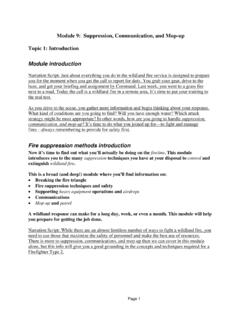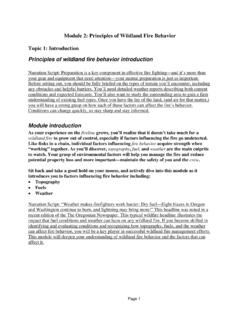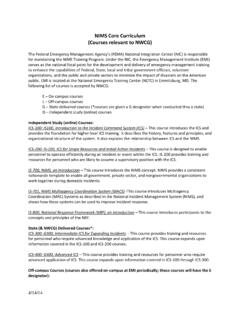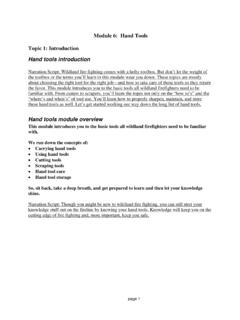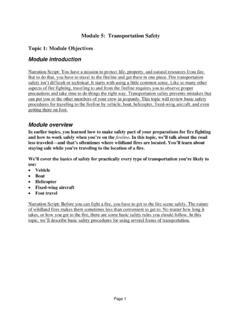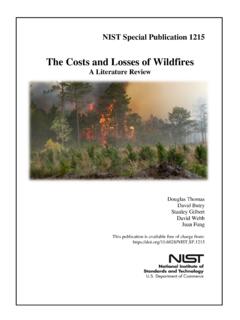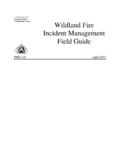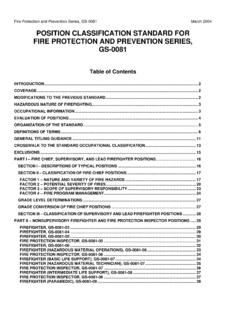Transcription of Module 11: Wildland/Urban Interface Topic 1: Introduction
1 Module 11: Wildland/Urban Interface Topic 1: Introduction Wildland/Urban Interface size-up Introduction Narration Script: You ve been dispatched to a grass and scrub fire at the corner of Highway 67 and Rampart Range Road. But this isn t your run-of-the-mill wildland fire now you have to deal with structures too. These are buildings that people call home. Homes that contain their possessions, their memories .. and their loved ones. For a growing number of fire departments, it s not just about wildland fires anymore; it s about the more complex issues of protecting the Wildland/Urban Interface .
2 Scenic beauty and changing lifestyles have motivated people to purchase and develop homes and businesses in once pristine areas. People, homes, and workplaces in these areas increase the wildland fire problem in many ways. And therefore, the wildland now becomes the Wildland/Urban Interface . However, before delving deeper into structure protection and fire suppression in the Interface , you have to recognize the unique aspects of size-up for these types of fires. Get ready to take what you have already learned and apply it in a new environment the Wildland/Urban Interface . That s our order of business in this Topic !
3 Wildland/Urban Interface Introduction Because fires in the Wildland/Urban Interface present specific issues, this Module is devoted to discussing the unique aspects of fire fighting in the Interface . First and foremost, we ll discuss your top priority safety. In the following Topic , you ll be reminded of specific fire fighting principles when you are in the Interface , including: Watch-out! scenarios just for use in the Interface Assessments to be made on a Wildland/Urban incident Operational modes available for an Interface tactical plan Narration Script: When fire spreads toward improved properties, you have a variety of tactics available to achieve the objectives stated in the incident action plan.
4 This may involve a combination of direct and indirect fire fighting methods as well as calling for various types of air- and ground-based resources. Page 1 Topic 2: Watch-Outs Topic Introduction Narration Script: You can pretty much guarantee that there will be fires coming to a Wildland/Urban Interface near you. Increased human activity multiplies both the ways that fires can start and the total number of fires in these areas. And many homes in the Interface are very expensive, greatly increasing the dollar value of property you are expected to protect. Many times, developments in the Interface have less than adequate fire protection.
5 Minimal planning and code enforcement often result in a random pattern of structure types in heavy vegetation and on terrain that provides breathtaking scenic vistas but also makes the structures vulnerable to fire. When these factors are combined with minimal fire fighting resources, a single fire can quickly destroy hundreds of structures and other improvements. Despite the value of the structures you find in the Wildland/Urban Interface , your safety and that of your fellow firefighters is the most important issue. The Wildland/Urban Interface Have you ever heard it said that someone is in the zone ?
6 For wildland firefighters, the zone will sometimes be the Wildland/Urban Interface known as the zone where human-made improvements intermix with wildland fuels. The Interface is where wildland strategies and tactics shift and where you might be exposed to unfamiliar hazards. In this Topic , we re going to show you how to stay safe while analyzing incidents and making good tactical decisions in the Interface . You ll examine: Foundational principles Interface Watch-out! scenarios Scene assessment considerations Interface response tactics Let s get started! Narration Script: When fire threatens structures in the Wildland/Urban Interface , the factors that can harm you take a sharp turn to the north.
7 While saving those structures is a priority, what matters most is your life. Smart firefighters don t risk their necks for buildings. So pay attention. We re about to tell you how to stay safe, and how to carefully analyze and make good tactical decisions while managing incidents in the Wildland/Urban Interface . Page 2 Foundational principles Before we get to the heart of this Topic , let s review some key foundational principles. The foundational principles are: Understand that your first priority is your safety your second priority is saving property and natural resources Know where your escape routes and safety zones are at all times Keep an eye on any potential problem areas Know your equipment placement guidelines Establish good communications with all involved agencies Adhere to the incident command system know who you are working for And don t forget these principles from your Incident Response Pocket Guide (IRPG).
8 LCES (lookouts, communications, escape routes, safety zones) 10 Standard Fire Orders 18 wildland Watch-out! situations Five-step risk management process You can find a copy of the IRPG in the resources associated with this course. Narration Script: No amount of training is guaranteed to keep you safe on every incident. But the more you know, the safer you will be. Guesswork has no place in a firefighter s world. You need to know exactly what to look for, how to react, and what to do. Let s begin by revisiting some foundational fire fighting principles specifically designed for the Wildland/Urban Interface .
9 Review these principles early and often. You can find these principles in your IRPG. It should be a pocket s length away from you at all times. Wildland/Urban Interface concerns You will be confronted with safety concerns in the Wildland/Urban Interface you might not otherwise see on a typical wildland fire. Simply stated, structural hazards are different from hazards on a wildland fire. Not only is structural defense an unfamiliar role for many wildland firefighters, but the value of homes can place undue psychological pressures on firefighters, leading to unfounded risk taking.
10 Don t take unnecessary risks. Homes can be rebuilt firefighters can t. Safety for yourself, the crew, and local residents are your top priorities. In a moment, we ll investigate some new Watch-outs! that are tailor-made for fighting fires in the Wildland/Urban Interface . Narration Script: Fighting fires in the Wildland/Urban Interface can be very different from engaging a strictly wildland incident, and it can be more dangerous. Structural fire fighting is complex and can involve such factors as electrical hazards and toxic materials. The value placed Page 3 on homes and the pressure from homeowners might compel you to take greater risks.

